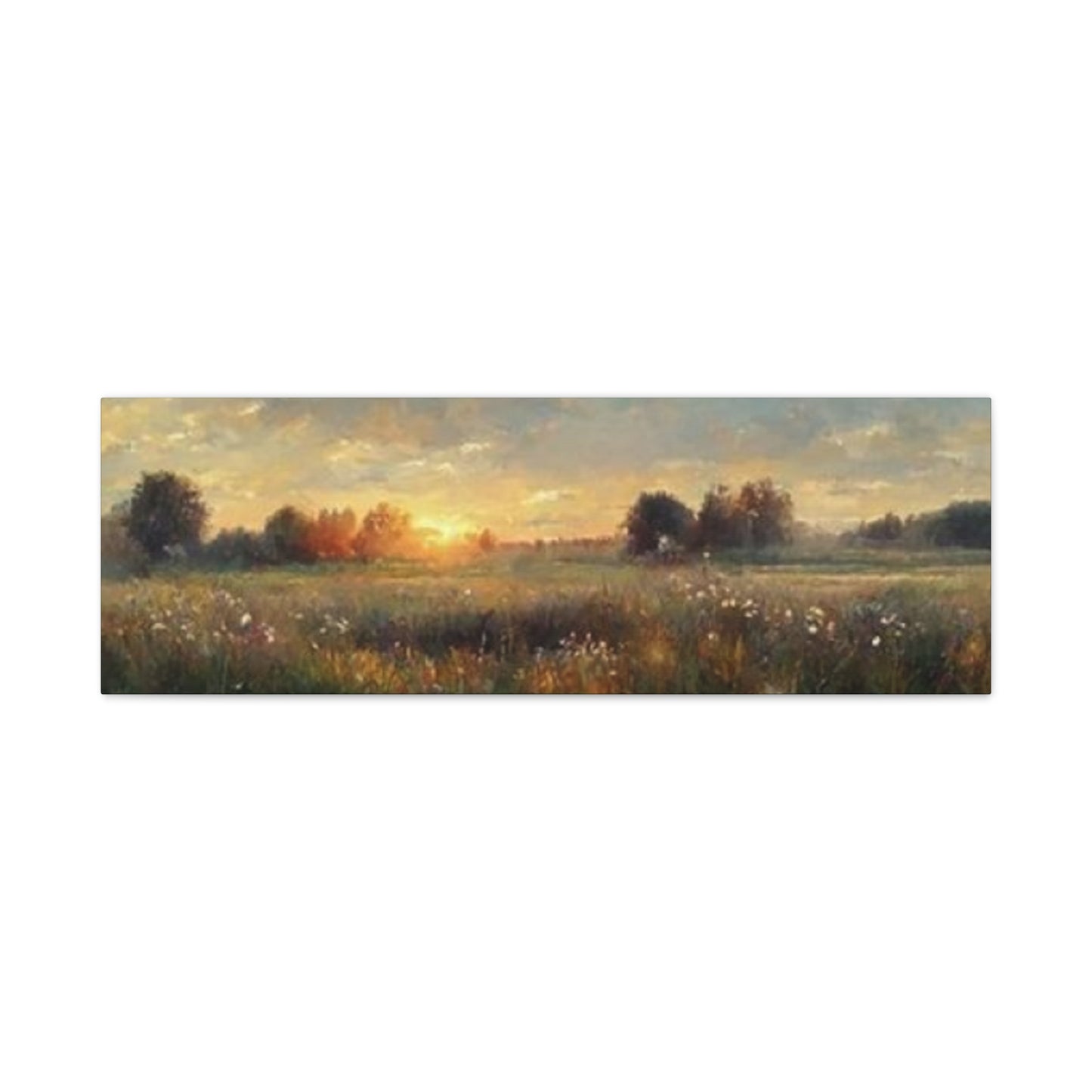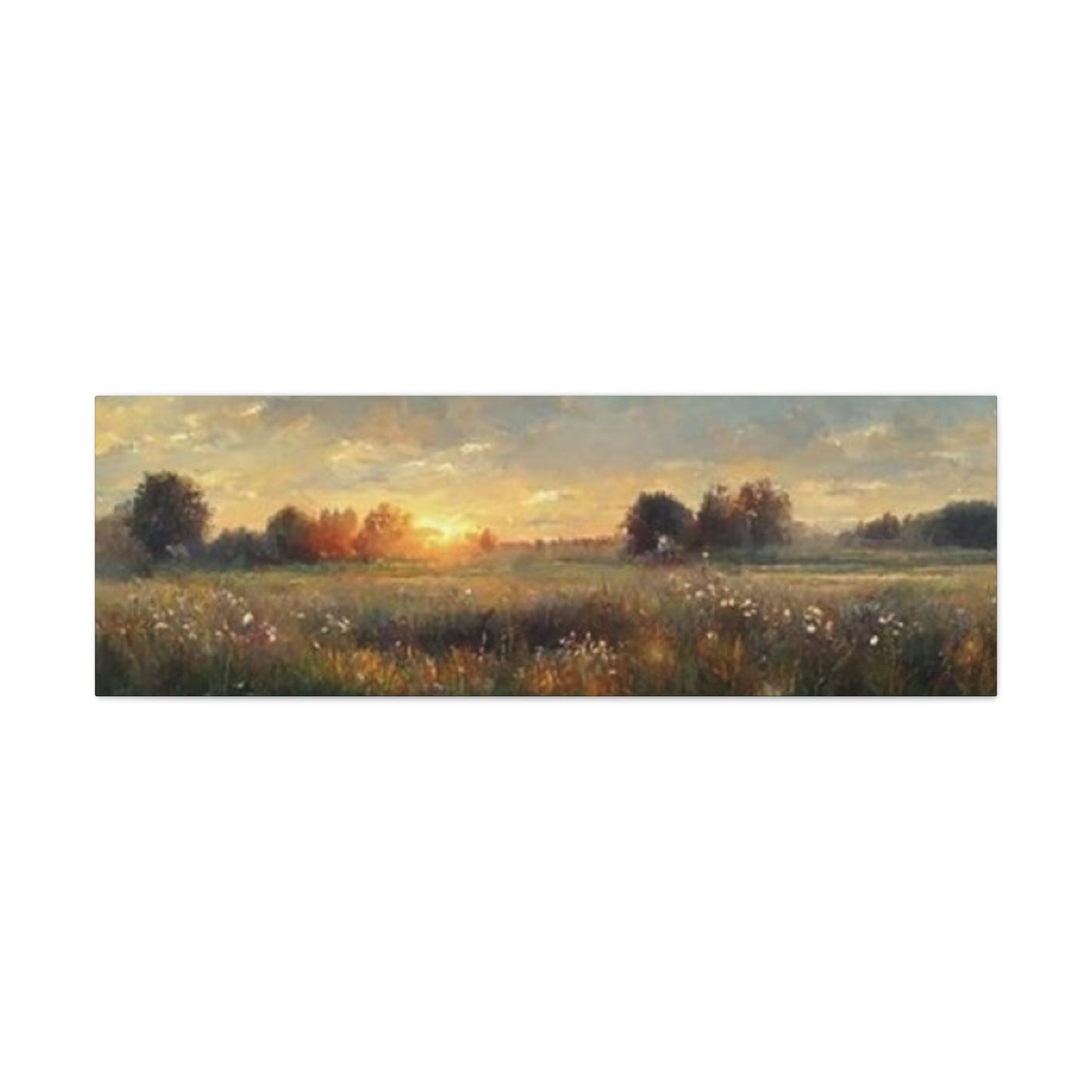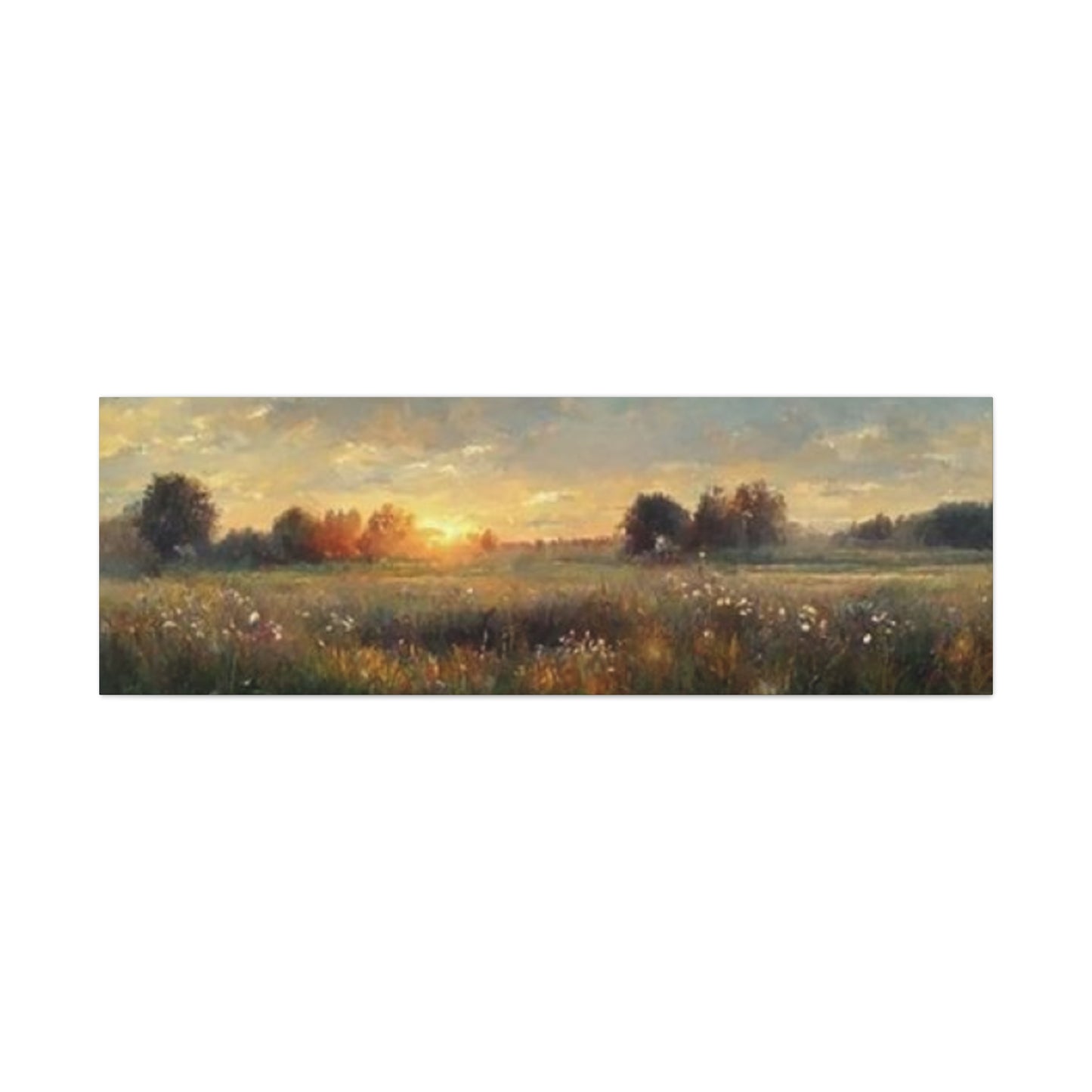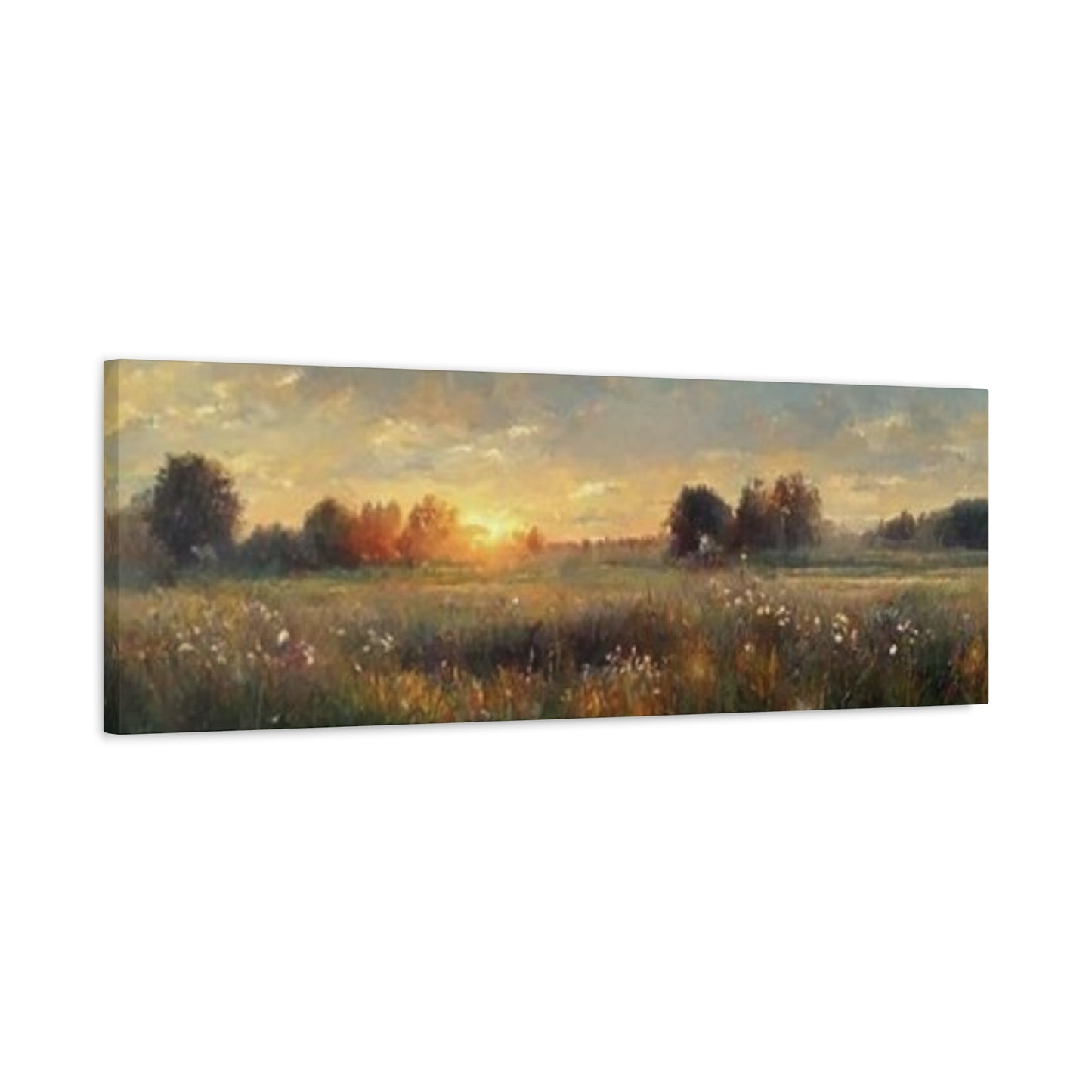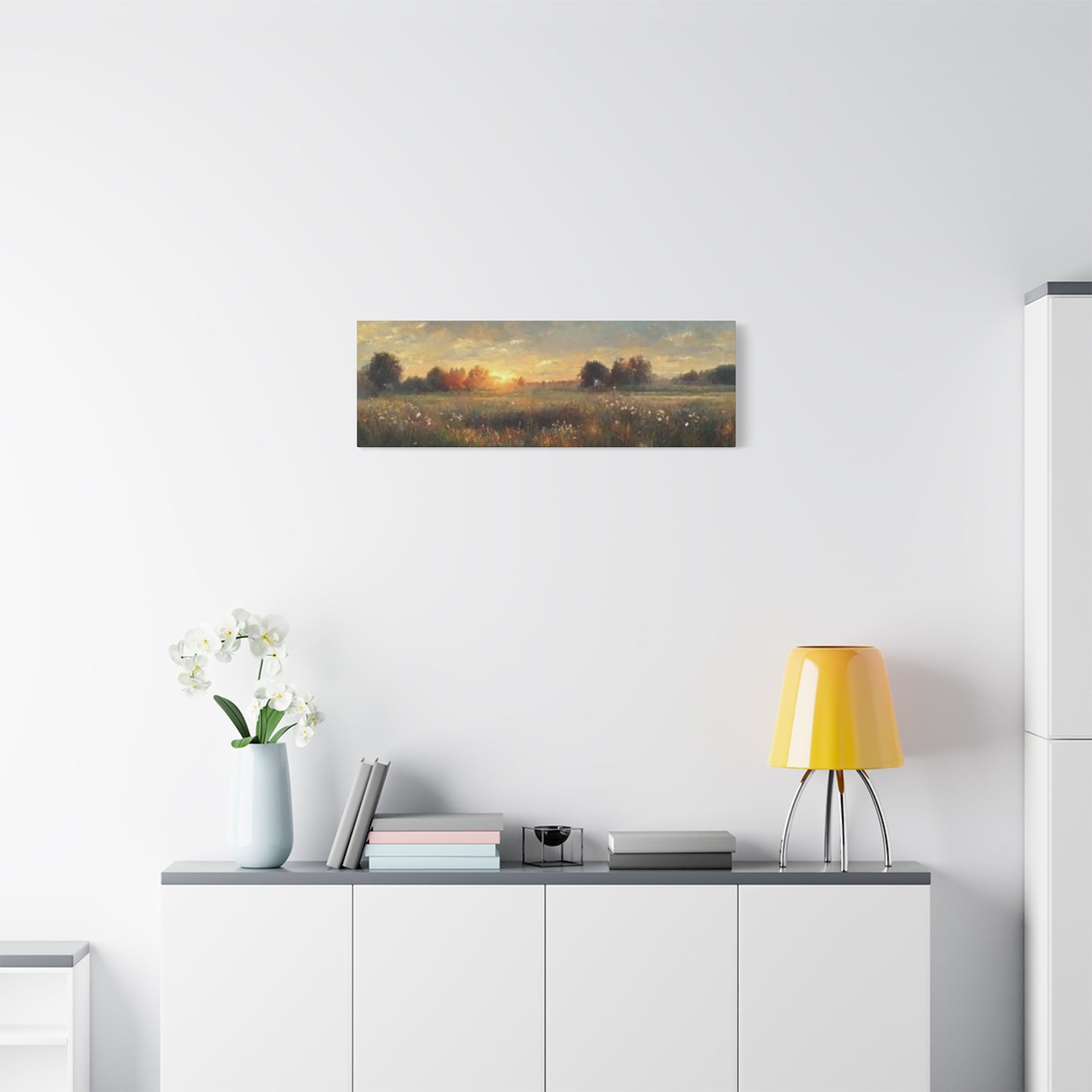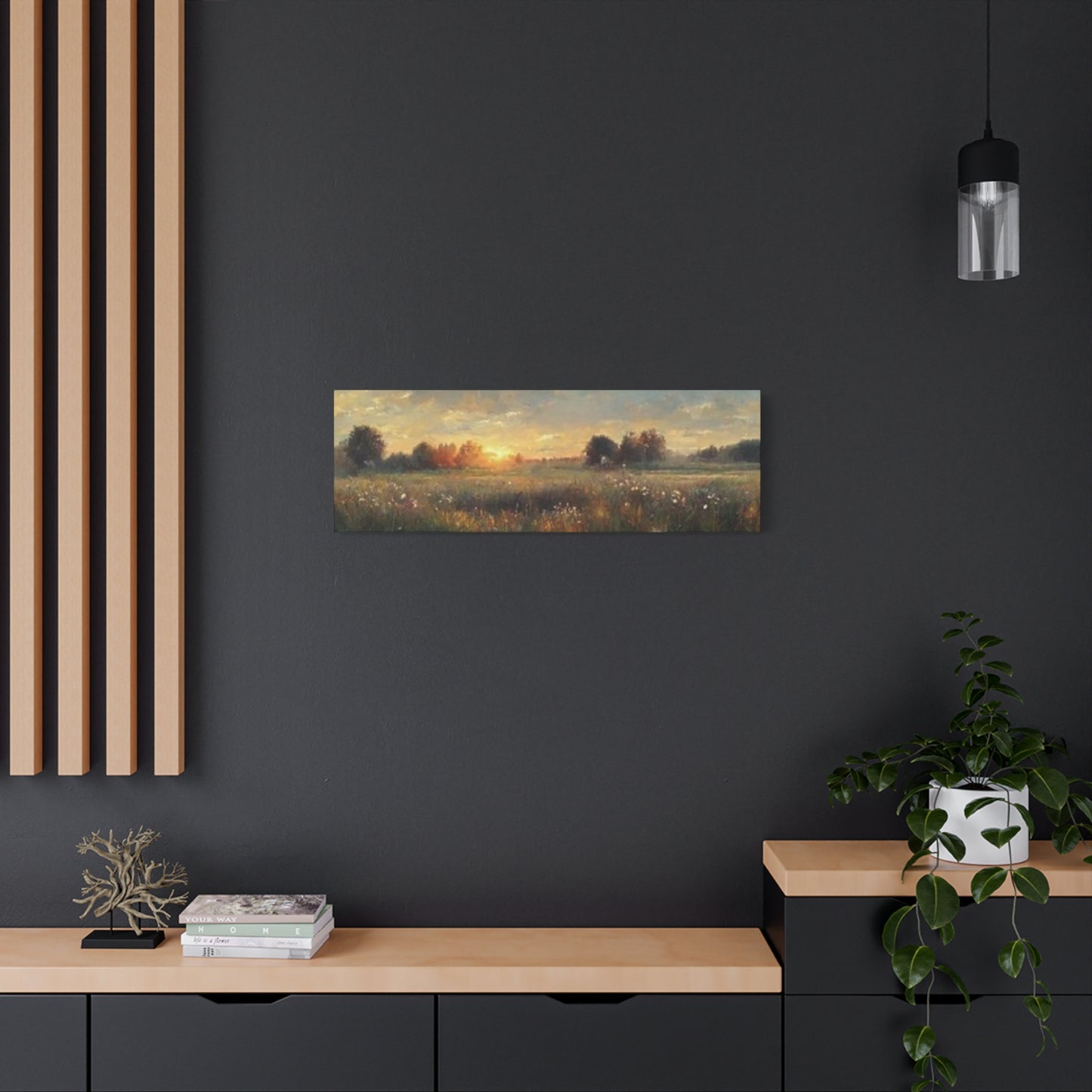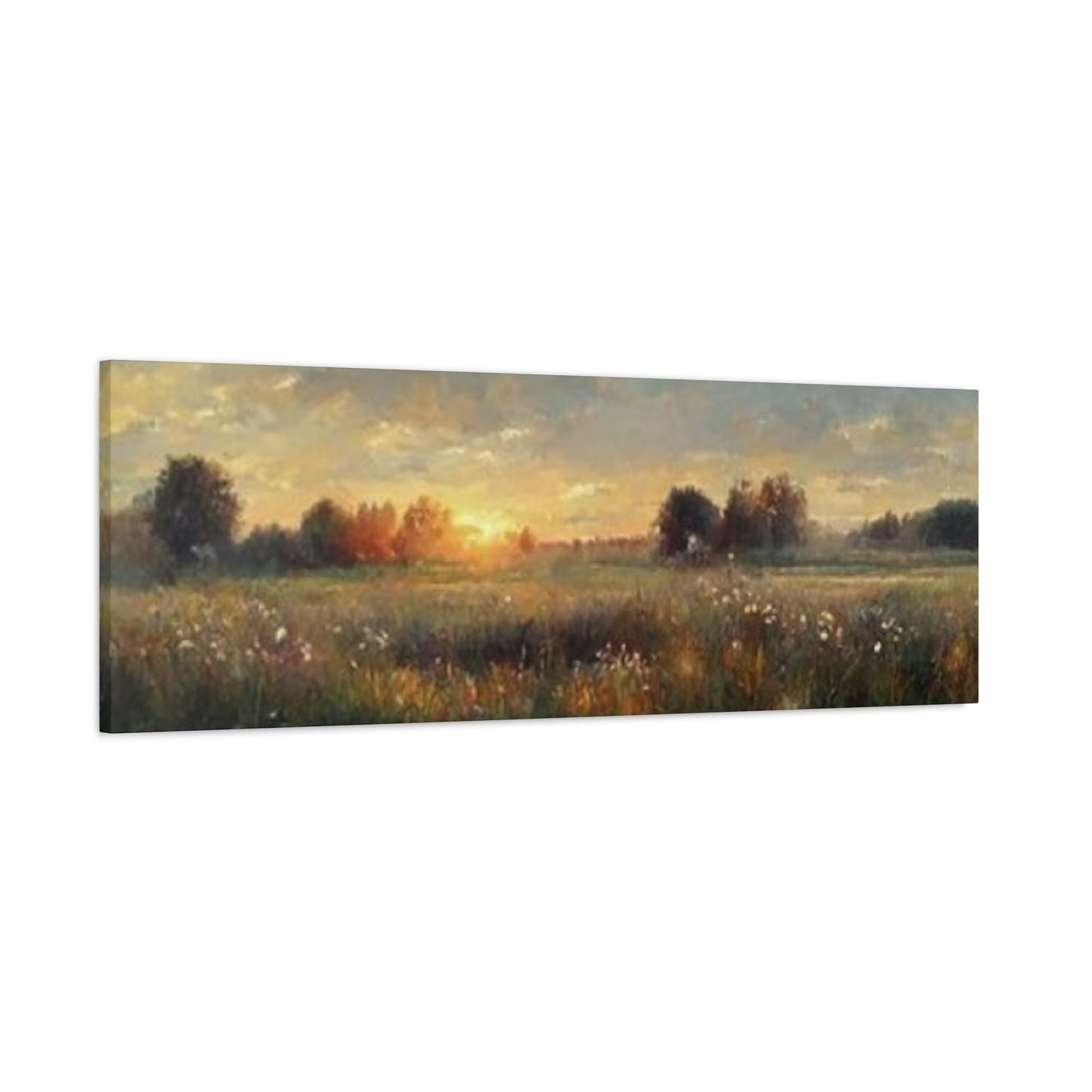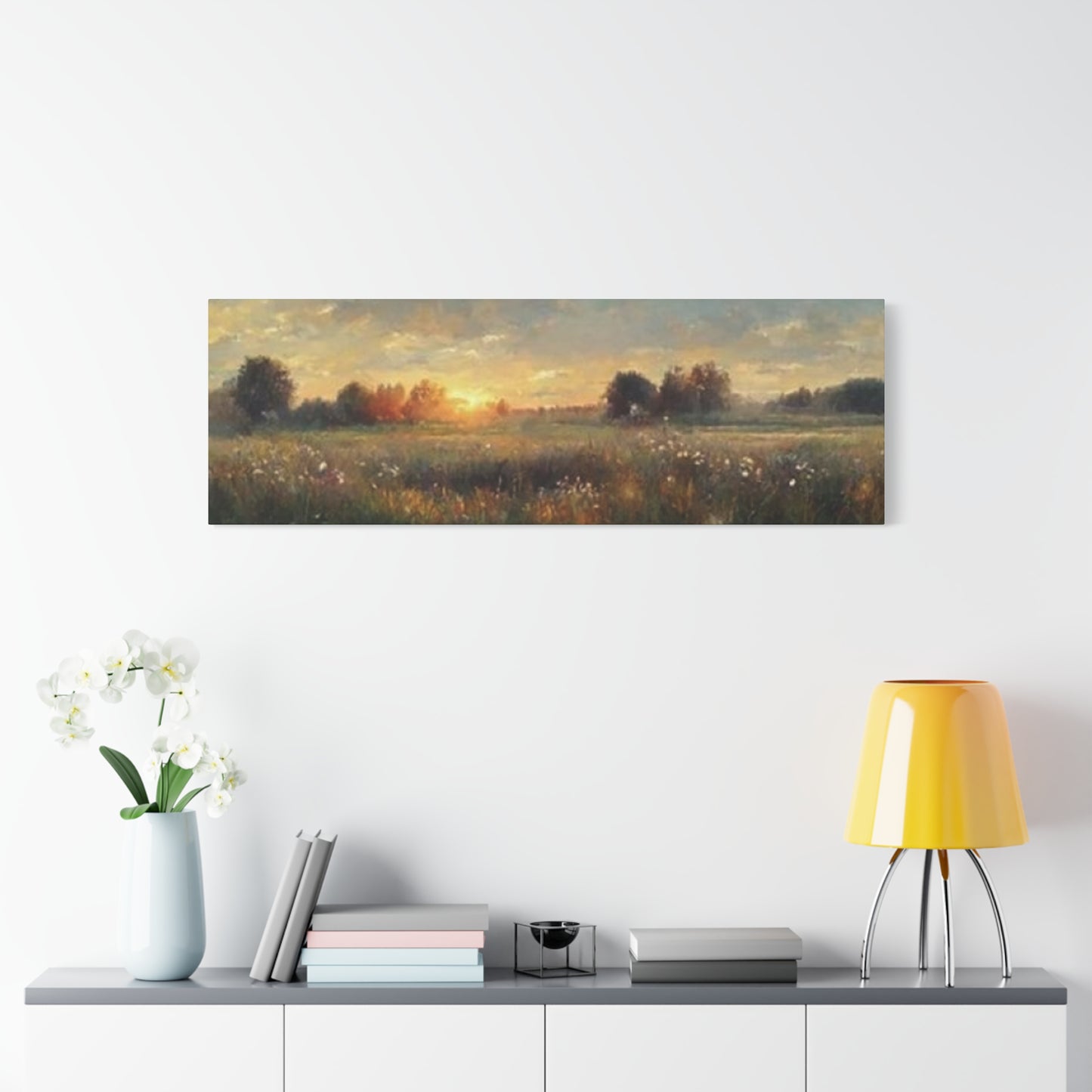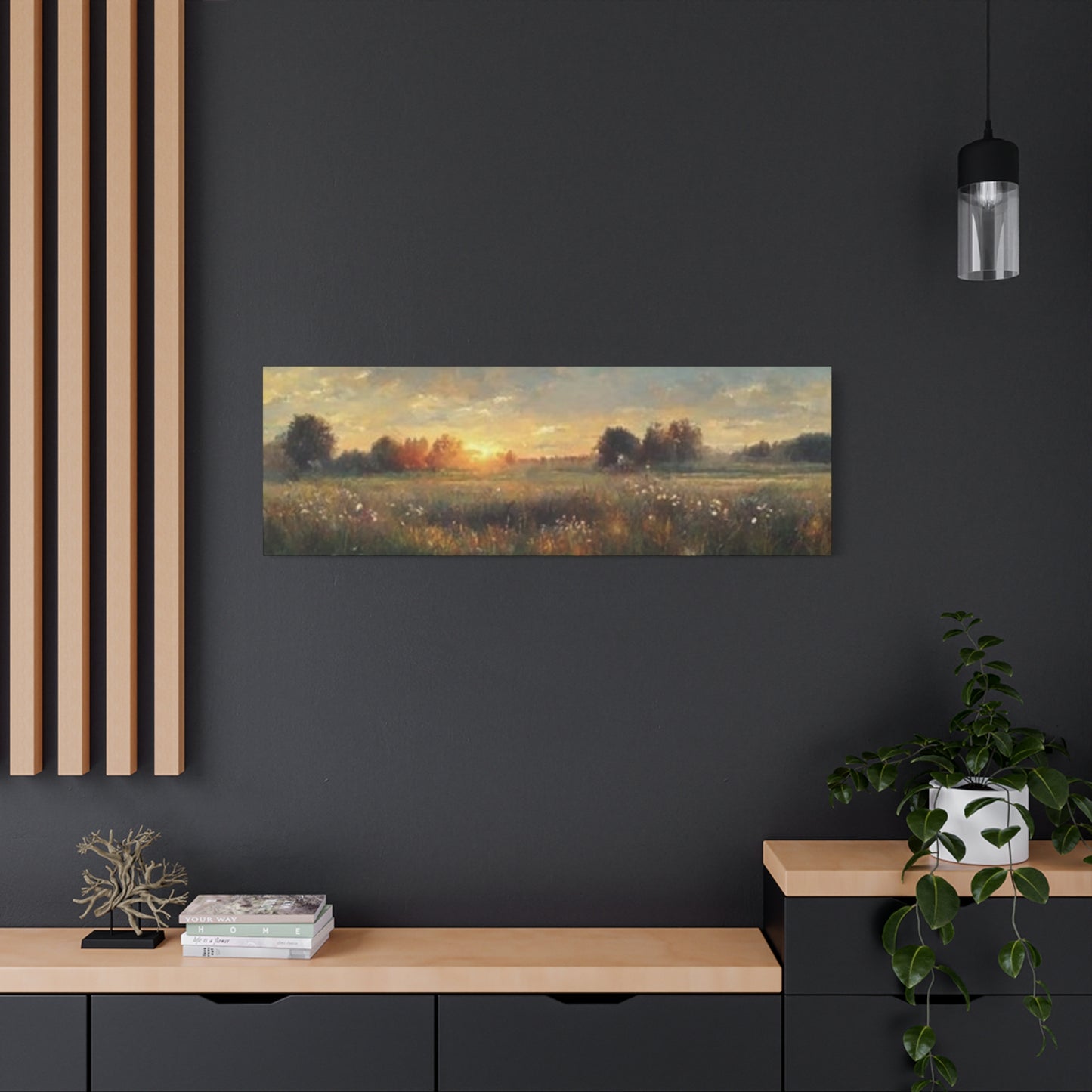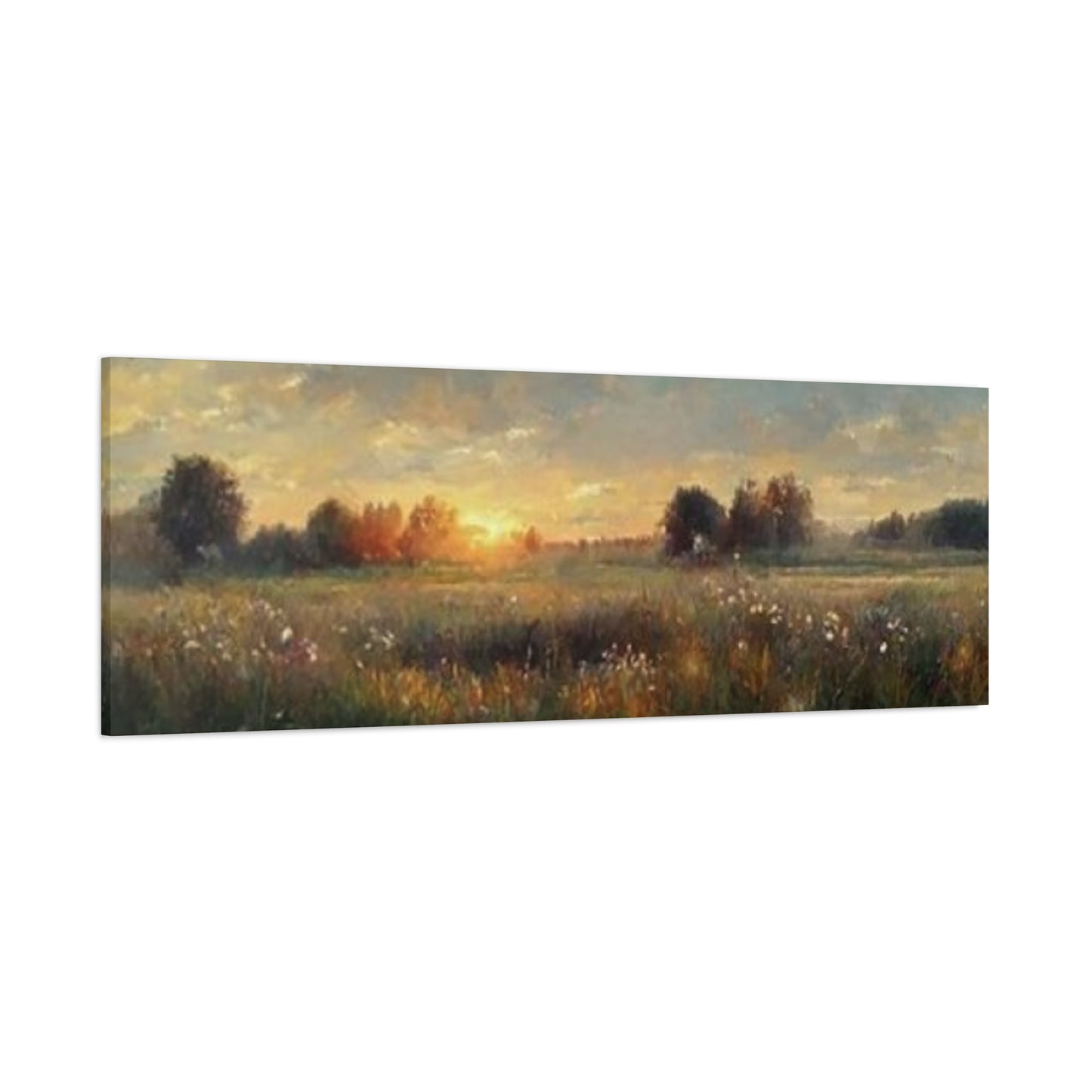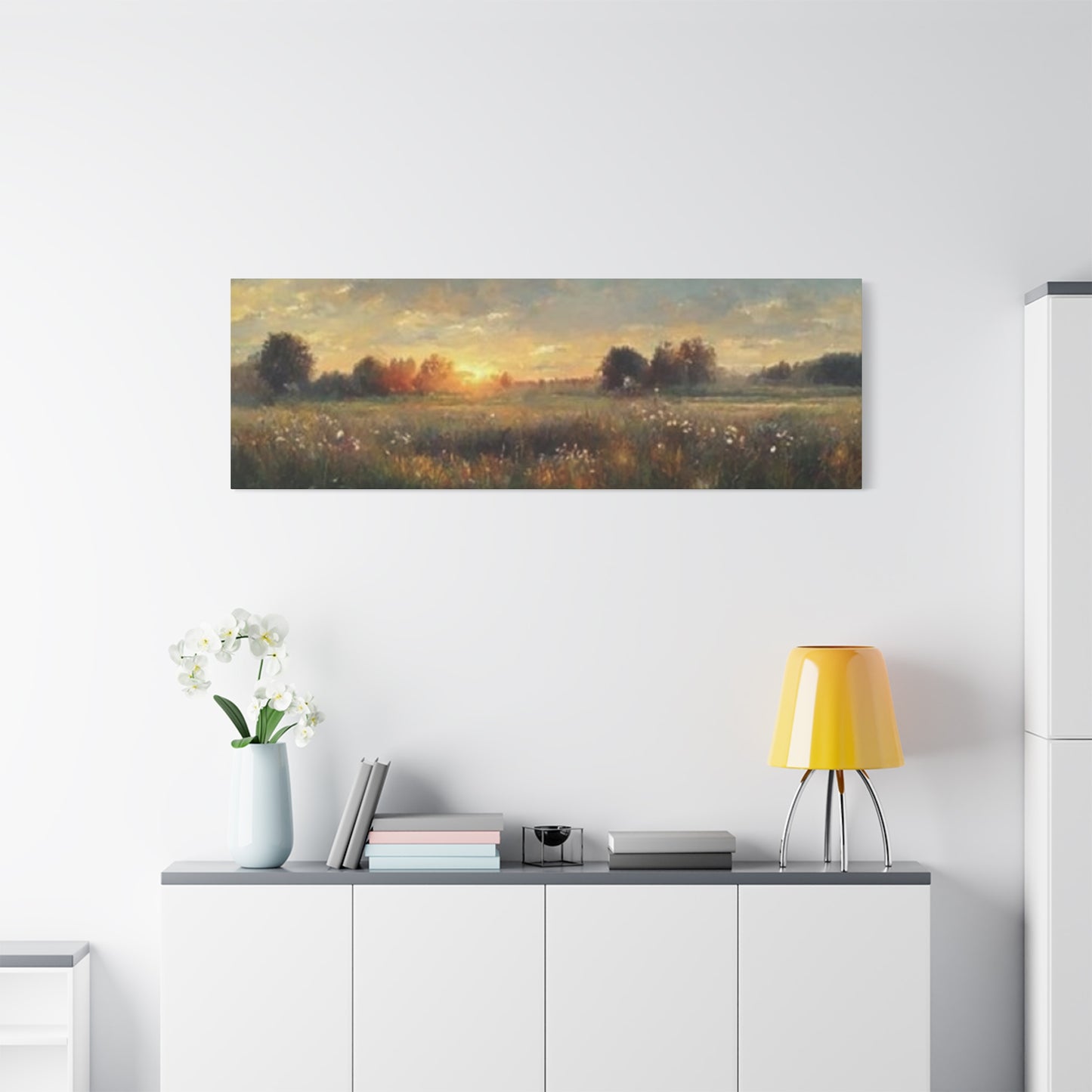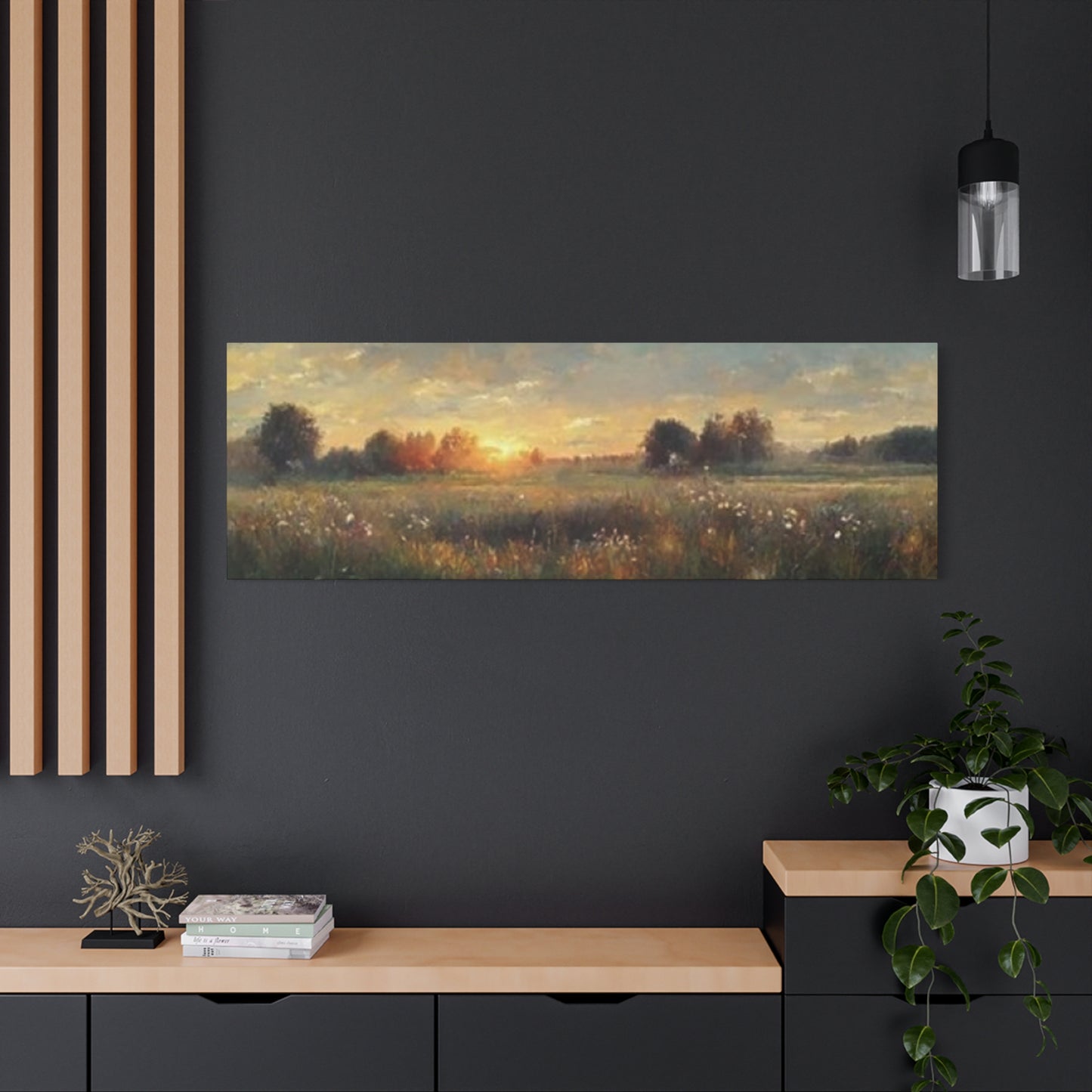Lush Green Wildlife Sunrise Panoramas Wall Art That Brings Nature's Dawn Into Your Home
The first light of dawn breaking over untamed wilderness creates moments of pure magic. When golden rays pierce through morning mist to illuminate verdant forests, rolling meadows, and wildlife in their natural habitat, something extraordinary happens. These fleeting instances of natural beauty have inspired artists and photographers for generations, and now they can transform your living environment through carefully selected panoramic prints that capture the essence of sunrise in wild places.
Wildlife panoramas depicting dawn's early light offer more than mere decoration. They serve as windows into pristine ecosystems, reminding us of the planet's raw beauty and the creatures that inhabit these landscapes. Whether showcasing deer grazing in dew-covered fields, birds taking flight against painted skies, or bears emerging from forest shadows, these pieces create emotional connections that standard decorative items simply cannot match.
The appeal of sunrise scenes lies in their universal ability to evoke feelings of renewal, hope, and tranquility. When combined with lush vegetation and wildlife subjects, these images become powerful focal points that can completely alter the atmosphere of any room. From compact prints perfect for cozy nooks to expansive panoramas that dominate entire walls, these artworks bring the serenity of nature's morning rituals directly into your daily life.
Capturing Sunrise in Green Wildlife Panoramas
The technical and artistic challenges of photographing or painting sunrise scenes in wildlife habitats require exceptional skill and patience. Artists who specialize in these works must understand both the behavior of animals during dawn hours and the rapidly changing qualities of light that characterize this time of day. The golden hour, as photographers call it, lasts only briefly, creating urgency to capture perfect compositions before the light changes dramatically.
Successful wildlife sunrise panoramas balance multiple complex elements simultaneously. The artist must position themselves to capture the sun's angle as it crests the horizon while also anticipating where wildlife subjects will appear within the frame. This requires extensive knowledge of animal patterns, seasonal movements, and habitat characteristics. Many professional wildlife photographers spend weeks or even months in specific locations, returning repeatedly to the same spot until conditions align perfectly.
The technical aspects of capturing these scenes involve sophisticated camera equipment and settings that can handle extreme contrasts between bright skies and shadowed foregrounds. High dynamic range techniques often come into play, allowing artists to preserve detail in both the brilliant sunrise and the darker elements of vegetation and wildlife. This ensures that viewers can appreciate every nuance, from individual leaves on trees to the texture of an animal's fur or feathers.
Composition plays a critical role in creating panoramic wildlife sunrise images that captivate viewers. The rule of thirds often guides placement of key elements, with the horizon line typically positioned either in the lower or upper third of the frame rather than dead center. This creates more dynamic and visually interesting compositions. Wildlife subjects might be placed at intersection points where imaginary grid lines meet, drawing the eye naturally to these focal areas.
The challenge of working with live wildlife subjects adds unpredictability to the creative process. Unlike landscape photography where elements remain static, animals move constantly and may enter or exit the frame unexpectedly. This requires photographers to maintain constant vigilance and readiness, often shooting hundreds or thousands of images during a single session in hopes of capturing a few perfect moments. The best wildlife sunrise panoramas often result from this combination of preparation, patience, and serendipity.
Seasonal variations dramatically affect the appearance of these scenes. Spring sunrises might feature newborn animals taking their first steps in morning light, while autumn captures might showcase wildlife preparing for winter against backdrops of changing foliage colors. Summer brings lush, saturated greens at their peak intensity, whereas winter scenes might contrast stark snow with evergreen forests. Each season offers unique opportunities for artists to explore different moods and color palettes.
Weather conditions add another layer of complexity and opportunity. Morning fog can create ethereal, dreamlike atmospheres where wildlife appears to emerge from mysterious mists. Clear skies produce sharp, vivid colors with defined shadows, while partially cloudy conditions might yield dramatic rays of light breaking through gaps in cloud cover. Professional wildlife artists learn to work with whatever conditions nature provides, often finding that imperfect weather creates the most memorable images.
The ethical considerations of wildlife photography deserve mention. Responsible artists never disturb animals or their habitats to achieve desired shots. They maintain appropriate distances, use long telephoto lenses, and avoid interfering with natural behaviors. This ethical approach requires even more patience and skill but ensures that the wildlife depicted in these panoramas continues thriving in their natural environments. The best images capture authentic moments of animals living their lives undisturbed by human presence.
Post-processing techniques allow artists to enhance and refine their captured images while maintaining authenticity. Adjustments to exposure, contrast, color saturation, and sharpness help bring out the full potential of raw photographs. However, ethical wildlife artists avoid manipulations that misrepresent reality, such as adding or removing elements, combining multiple images deceptively, or altering animal appearances. The goal remains faithful representation of genuine moments in nature.
Digital painting and mixed media approaches offer alternative methods for creating wildlife sunrise panoramas. Some artists work from photographic references to create paintings that capture the emotional essence of dawn in wild places while taking artistic liberties with colors, composition, and style. These interpretive works can be equally powerful, offering perspectives that transcend the limitations of photography through imaginative enhancement of natural beauty.
Vibrant Colors in Wildlife Sunrise Art
The color palette of sunrise creates one of the most compelling aspects of wildlife panoramas. As the sun ascends from below the horizon, its light must travel through more of Earth's atmosphere than at any other time of day. This atmospheric filtering scatters shorter wavelengths of light while allowing longer wavelengths to pass through, creating the warm oranges, reds, pinks, and golds that characterize dawn. These warm tones contrast beautifully with the cool blues and purples that linger in shadows and unlit portions of the sky.
The interplay between warm sunrise tones and the cool greens of vegetation creates visual tension that makes these images particularly engaging. Lush forests, meadows, and marshlands appear in deep, saturated greens during the blue hour before sunrise, then gradually shift as warming light illuminates foliage. This transformation from cool to warm tones happens progressively across the landscape, creating gradients and transitions that add depth and dimension to panoramic compositions.
Wildlife subjects themselves contribute additional colors to these complex scenes. The earthy browns and tans of deer, the brilliant plumage of birds, the varied coats of different mammal species all interact with the changing light of sunrise. Backlighting can create glowing halos around animal silhouettes, while side lighting reveals textures and details in fur and feathers. The positioning of wildlife relative to the light source dramatically affects how their colors appear within the overall composition.
Color saturation varies throughout a sunrise sequence, beginning with subtle pastels as first light appears, building to peak intensity as the sun nears the horizon, then gradually normalizing as full daylight arrives. Artists who capture wildlife during different phases of this progression create works with distinctly different emotional impacts. Early pre-dawn images tend toward contemplative, peaceful moods with their softer colors, while peak sunrise moments burst with energy and vibrancy.
The phenomenon of reflected light adds complexity to color relationships in wildlife sunrise panoramas. Light bouncing off water surfaces, dewy vegetation, or mist-filled air can cast unexpected hues onto subjects. A deer standing near water might pick up reflections of pink or orange sunrise tones from the surface, while birds flying through illuminated mist might appear to glow with transmitted light. These subtle color interactions create rich, layered images that reward careful viewing.
Complementary color relationships often appear naturally in these scenes. The orange-blue complementary pair shows up frequently, with warm sunrise skies contrasting against cool shadowed areas. Green vegetation and occasional magenta or purple tones in skies or flowers create another complementary relationship. These naturally occurring color harmonies contribute to the immediate visual appeal of wildlife sunrise panoramas, making them inherently pleasing to human perception.
Artists sometimes enhance color saturation during post-processing to create more dramatic, eye-catching prints. While subtle enhancement can help prints match the vibrancy that our eyes perceived at the scene, excessive saturation can make images appear artificial or garish. The most skilled artists find the balance point where colors feel rich and alive without crossing into unrealistic territory. This judgment requires both technical knowledge and aesthetic sensitivity.
Regional variations affect the color characteristics of wildlife sunrise panoramas significantly. Tropical locations might feature more intense, saturated colors with stronger contrasts between light and shadow. Temperate regions often display more subtle, nuanced color transitions with softer overall tones. Arctic and subarctic areas can produce extraordinarily long, drawn-out sunrises with colors that seem to glow from within the landscape. Each geographic location offers its own distinct color personality.
Seasonal changes dramatically alter color relationships throughout the year. Spring sunrises often feature fresh, bright greens and pastel sky tones that communicate renewal and growth. Summer brings deep, mature greens and occasionally more dramatic skies with stronger color contrasts. Autumn introduces warm foliage colors that harmonize with sunrise tones, creating monochromatic warmth. Winter offers stark contrasts between snow, evergreens, and colorful skies, producing some of the most dramatic color relationships of any season.
The psychological effects of these vibrant colors should not be underestimated. Warm sunrise tones are associated with positive emotions, energy, and optimism. Green hues promote feelings of calm, balance, and connection to nature. The combination of these color families in wildlife sunrise panoramas creates artwork that can genuinely affect mood and atmosphere in living environments. This makes color selection an important consideration when choosing prints for specific purposes or locations.
Small vs Large Wildlife Panorama Prints
The physical dimensions of wildlife sunrise panorama prints significantly impact their visual effect and appropriate applications. Small prints, typically ranging from eight by ten inches to sixteen by twenty inches, offer versatility and intimacy. These compact sizes work beautifully in arrangements with other artworks, on smaller walls, or in locations where massive prints would overwhelm the available area. They invite closer viewing, encouraging observers to study details and discover nuances that might go unnoticed in larger formats.
Small format prints excel in creating gallery walls where multiple images tell a broader story about wildlife and sunrise scenes. A collection of smaller panoramas depicting different seasons, locations, or animal species can be arranged in visually interesting patterns that create impact through their collective presence rather than individual size. This approach allows for more flexibility in arrangement and makes it easier to update or rotate artworks seasonally or according to changing preferences.
The affordability factor makes small prints accessible to broader audiences. Production costs decrease with dimensions, and these prints require less expensive framing and mounting solutions. For those beginning to collect wildlife artwork or working within budget constraints, smaller formats provide entry points into acquiring high-quality pieces. They also make excellent gifts, as their modest size makes them easier to transport and suitable for recipients with various living situations.
Medium-sized prints, roughly eighteen by twenty-four inches to thirty by forty inches, occupy a middle ground that suits many residential applications. These dimensions create meaningful presence on walls without requiring excessive space or dominating rooms. They work particularly well above furniture pieces like sofas, beds, or console tables, where their proportions can complement and balance the dimensions of these furnishings. Medium prints strike a balance between detail visibility and overall impact.
Large panoramic prints, measuring forty inches wide or greater, transform into architectural elements that fundamentally alter how we experience rooms. These substantial pieces command attention immediately upon entering an environment and serve as primary focal points around which other design elements orbit. The immersive quality of large wildlife sunrise panoramas can transport viewers mentally into the depicted scenes, creating powerful emotional connections and sense of presence.
The horizontal orientation inherent to panoramic formats particularly suits wide wall expanses, such as those above sectional sofas, in hallways, or spanning the space between windows or doorways. Panoramas naturally draw the eye laterally across their length, creating visual movement and narrative flow. This horizontal emphasis can make rooms feel wider and more spacious, particularly when the panorama depicts expansive landscapes with distant horizons.
Print resolution and viewing distance become critical considerations as size increases. Small prints viewed from typical distances of two to four feet can successfully use lower resolution source images, while large prints must originate from extremely high-resolution captures to maintain sharp detail when viewed from appropriate distances. Professional wildlife photographers shooting for large-format printing use medium or large format cameras, or capture multiple images to stitch into extremely high-resolution composites.
The choice between small and large prints should consider both the physical characteristics of the installation location and the intended emotional impact. Intimate settings like bedrooms, home offices, or reading nooks might benefit from smaller, more personal-scale prints that create cozy atmospheres. Public or entertaining areas such as living rooms, dining rooms, or entry halls often call for larger statements that welcome guests and set tones for these social environments.
Installation challenges increase with print size. Small pieces can be hung easily with basic hardware and techniques, while large panoramas might require professional installation with specialized anchoring systems to ensure safety and prevent damage. The weight of large prints, particularly those printed on canvas with substantial stretcher bars or those behind large panes of acrylic or glass, can be considerable. Wall structure and stud locations become important factors in planning installations.
Multiple small prints arranged as a unified installation can create similar visual impact to a single large print while offering more flexibility. A triptych of related wildlife sunrise images, for instance, might span the same wall width as one large panorama but allow for spacing that accommodates light switches, thermostats, or other wall features. This modular approach also permits easier handling during moves or room rearrangements.
Print pricing generally increases exponentially rather than linearly with size. A print twice as large in dimensions might cost three or four times as much, accounting for material costs, printing complexity, and shipping challenges. This pricing structure means that budget considerations often heavily influence size decisions. However, the impact per dollar might actually favor larger prints for those able to invest in them, as they create disproportionately greater visual presence.
Caring for Wildlife Sunrise Canvas Art
Canvas prints offer a popular medium for wildlife sunrise panoramas, providing texture and dimensionality that flat paper prints cannot match. The woven surface of canvas adds visual interest and helps these pieces read as more substantial artworks rather than simple photographs. However, canvas requires specific care practices to ensure longevity and maintain appearance over years or decades of display.
Ultraviolet light presents one of the most significant threats to canvas prints, particularly those featuring the vibrant colors characteristic of sunrise scenes. UV radiation causes fading, yellowing, and deterioration of both inks and canvas materials over time. Prints displayed in direct sunlight or near windows without UV-filtering glass face accelerated degradation. Protective measures include applying UV-resistant sprays to the canvas surface, using UV-filtering window films, or simply positioning artwork away from direct sun exposure.
The protective coating applied to canvas prints serves multiple purposes beyond UV protection. Quality sealants guard against moisture, dust accumulation, and accidental contact damage. They also enhance color vibrancy and provide a surface that can be gently cleaned when necessary. Some coatings add gloss or satin finishes that affect the final appearance, while others maintain matte surfaces. Reapplication of protective coatings every few years extends the life of canvas prints significantly.
Humidity control matters considerably for canvas artwork longevity. Excessive moisture can cause canvas to sag, warp, or develop mold and mildew. Conversely, extremely dry conditions might cause canvas to become brittle or crack. Maintaining indoor humidity levels between thirty and fifty percent creates optimal conditions for canvas preservation. Locations like bathrooms or basements with high moisture exposure are generally unsuitable for canvas artwork without special precautions.
Temperature fluctuations can also affect canvas prints, causing expansion and contraction that stresses both the canvas material and the stretcher bars supporting it. Dramatic temperature swings might lead to canvas loosening on its frame or, in extreme cases, separation of print layers. Avoiding placement near heating vents, air conditioning units, or fireplaces helps minimize these temperature-related stresses. Consistent, moderate temperatures preserve canvas integrity longest.
Dust accumulation represents a gradual but persistent challenge for canvas prints. The textured surface that makes canvas visually interesting also traps airborne particles more readily than smooth surfaces. Regular dusting using soft, clean microfiber cloths or gentle vacuuming with brush attachments prevents buildup that can dull colors and embed into the canvas weave. Always dust from top to bottom and use light, gentle strokes to avoid surface damage.
For more thorough cleaning when dust builds up despite regular maintenance, slightly dampened cloths can be used with extreme caution. The cloth should be barely moist, never wet, and gentle dabbing motions work better than rubbing. Any moisture should evaporate quickly after application. Canvas prints with protective coatings tolerate this careful cleaning better than uncoated pieces. Testing cleaning methods on an inconspicuous corner before treating the entire surface is always prudent.
Physical damage to canvas can sometimes be repaired, unlike damage to paper prints which often becomes permanent. Small tears or punctures might be patched from behind, and sagging canvas can be re-stretched on its frame. Professional art restorers can address more significant damage, though prevention through careful handling and appropriate placement obviously beats restoration. When moving or transporting canvas prints, protecting corners and avoiding pressure on the canvas surface prevents most common damage.
The stretcher bar system supporting canvas prints requires occasional attention. Over time, canvas may loosen slightly, causing ripples or sagging. Some stretcher systems include small wooden keys in the corners that can be gently tapped deeper into their slots to increase tension and restore tautness. This process must be done carefully and incrementally, tapping opposite corners alternately to maintain even tension across the canvas surface.
Storage considerations matter when canvas prints need to be temporarily removed from display. Storing them flat in climate-controlled areas protects them better than leaning vertically or stacking prints on top of each other. Covering stored pieces with clean, breathable fabric rather than plastic prevents dust accumulation while allowing air circulation that prevents moisture buildup. Never store canvas prints in attics, basements, or garages where temperature and humidity fluctuations are extreme.
Professional conservation measures become worthwhile for particularly valuable or meaningful wildlife sunrise canvas prints. Conservation-grade framing, specialized UV-protective glazing, and archival mounting techniques can extend artwork lifespans indefinitely. While these measures involve higher initial costs, they provide peace of mind for pieces with significant financial or sentimental value. Consulting with professional framers or art conservators provides guidance specific to individual pieces and situations.
Framing Ideas for Lush Green Panoramas
Frame selection dramatically influences how wildlife sunrise panoramas integrate into living environments and affects how viewers perceive the artwork itself. The frame serves as a transition zone between artwork and surroundings, either enhancing or detracting from the piece's impact. For panoramic prints featuring lush vegetation and sunrise scenes, frame choices that complement the natural subject matter typically work most successfully.
Natural wood frames create obvious harmony with wildlife and nature themes. The organic textures and warm tones of wood echo elements within the panoramas themselves, creating visual continuity. Different wood species offer varying color temperatures and grain patterns. Lighter woods like maple or ash provide subtle framing that doesn't compete with the artwork, while richer woods like walnut or cherry add warmth and sophistication. Distressed or reclaimed wood frames inject rustic character appropriate for wilderness subjects.
Modern minimalist frames in simple black or white profiles suit contemporary environments where clean lines and understated elegance dominate. These frames essentially disappear, allowing the panoramic image to take full prominence. Black frames tend to ground images and create definite boundaries, while white frames can make prints feel more airy and integrated with light-colored walls. The thinness of the frame profile affects impact; very thin frames barely interrupt the visual flow, while slightly thicker profiles provide more definition.
Metal frames offer industrial or contemporary aesthetics that can create interesting contrasts with natural wildlife subjects. Brushed aluminum, bronze, or copper finishes add sophistication without the warmth of wood. These frames work particularly well in modern or transitional settings where mixing materials creates visual interest. The cool tones of metal can actually enhance the warm sunrise tones in prints through complementary contrast.
Floating frames create the illusion that canvas or paper prints hover within the frame structure, separated by a gap between the artwork edges and the frame itself. This technique adds dimensionality and contemporary flair while allowing the full image to remain visible without overlapping frame elements. Floating frames work especially well for panoramic formats, emphasizing their horizontal extension and creating shadow lines that enhance depth perception.
Gallery wrapping represents an alternative to traditional framing for canvas prints. In this approach, the printed image extends around the edges of the stretcher bars, allowing the canvas to be displayed without any frame at all. The wrapped edges can mirror the front image or feature complementary solid colors. This frameless presentation emphasizes the casual, accessible nature of the artwork and works beautifully in relaxed, informal settings.
Double matting adds sophistication to framed prints while providing additional visual separation between artwork and frame. The inner mat typically appears in a color pulled from the print itself, perhaps a cream or soft green that echoes vegetation tones, while the outer mat might be a neutral that coordinates with room colors. The layered effect creates depth and draws attention inward toward the central image. Mat widths can be adjusted to suit print proportions and frame sizes.
Color coordination between frames and room environments requires thoughtful consideration. Frames that match wall colors allow prints to integrate seamlessly, creating cohesive, calming effects. Frames that contrast with walls make artwork stand out as distinct features, commanding more attention. For wildlife sunrise panoramas with their naturally attention-grabbing content, either approach can work depending on whether the goal is integration or emphasis.
Shadow box framing creates physical depth by mounting prints away from the backing, typically separated by one to two inches. This technique works particularly well for panoramic formats, as the shadow adds dramatic emphasis to the horizontal dimension. The resulting three-dimensional quality makes the artwork feel more sculptural and substantial. Shadow boxes also accommodate mounting printed canvas without flattening it against backing, preserving its dimensional quality.
Ornate or decorative frames can overwhelm wildlife sunrise panoramas if not carefully chosen. These busy frames compete with the already visually rich content of vibrant sunrise colors and wildlife subjects. However, in traditional or classical settings, carefully selected decorative frames in appropriate scales can add grandeur and formality. The key lies in ensuring the frame style complements rather than fights with the artwork's inherent characteristics.
Corner samples displayed at framing shops allow side-by-side comparison of frame options with the actual print. Taking advantage of this service before committing to frame purchases prevents costly mistakes. Seeing how different frame colors, materials, and profiles interact with specific prints provides invaluable information that descriptions or online images cannot convey. Professional framers can also offer design advice based on experience with similar projects.
Proper mounting and backing materials affect how framed prints appear and how long they last. Acid-free materials prevent yellowing and deterioration over time. Mounting prints away from glazing prevents condensation damage and allows air circulation. Conservation-grade materials cost more but provide significantly better protection for artwork intended as long-term features. Discussing these technical aspects with framing professionals ensures choices align with preservation goals.
Using Wildlife Sunrise Art to Refresh Walls
Existing living environments can feel stale or uninspiring over time as we become habituated to our surroundings. Introducing wildlife sunrise panoramas offers a powerful method for revitalizing these familiar areas without undertaking major renovations or furniture replacements. The transformative impact of well-chosen artwork often surprises people, demonstrating how much visual elements affect our perception and enjoyment of environments.
The psychological refreshment that nature imagery provides has been documented extensively in research. Views of natural environments, even through photographs or paintings, reduce stress, lower blood pressure, and improve mood. Wildlife sunrise panoramas specifically combine multiple beneficial elements: natural landscapes, living creatures, and the hope and renewal associated with dawn. Bringing these images into living areas creates daily opportunities for psychological restoration and connection with nature.
Strategic placement determines how effectively artwork refreshes environments. The primary focal wall in each room presents the most impactful location for significant pieces. In living rooms, this typically means the wall facing seating areas or the one housing the television or fireplace. In bedrooms, the wall behind the bed or directly facing it offers prime positioning. Placing wildlife sunrise panoramas in these high-visibility locations ensures they regularly capture attention and influence room atmospheres.
Replacing existing artwork with fresh wildlife sunrise panoramas represents the most straightforward refreshment approach. This direct substitution immediately changes the visual character of affected areas. The transformation feels especially dramatic when replacing muted, abstract, or dark imagery with vibrant sunrise scenes. The shift toward natural subjects and warm colors creates noticeable mood changes that occupants often report feeling immediately.
Creating gallery walls centered around wildlife sunrise themes allows for more gradual refreshment and greater flexibility. Starting with one panoramic print as an anchor piece, additional related images can be added over time. This approach spreads investment across multiple purchases and permits evolution as tastes develop or new compelling images become available. The cumulative effect of multiple nature pieces creates immersive environments that feel deeply connected to the outdoors.
Seasonal rotation of wildlife sunrise panoramas keeps living environments feeling current and responsive to the passing year. Spring images featuring newborn animals and fresh vegetation suit the renewal energy of that season. Summer pieces with lush, fully developed greenery match the abundance of those months. Autumn scenes with changing colors and harvest imagery reflect that transitional time, while winter panoramas acknowledge the year's contemplative period. This rotation prevents visual stagnation while maintaining thematic consistency.
Unexpected locations throughout homes can benefit from wildlife sunrise panoramas. Hallways often feel neglected but see frequent traffic, making them ideal for artwork that provides regular visual interest. Stairway walls offer vertical expanses perfect for tall or multiple panoramic prints arranged vertically. Kitchen and dining areas, increasingly designed as gathering spots, welcome artwork that sparks conversation and creates ambiance conducive to communal meals.
Coordinating artwork with existing color schemes ensures harmonious integration rather than jarring conflict. Wildlife sunrise panoramas naturally contain greens that complement many popular neutral palettes, while their warm sunrise tones add energy without clashing with most color directions. For rooms with cooler color schemes heavy on blues or grays, these warm-toned prints provide balancing contrast. In warmer rooms with abundant browns, tans, or warm neutrals, they reinforce and deepen existing color stories.
Lighting considerations affect how wildlife sunrise panoramas appear and function as refreshing elements. Well-lit artwork reveals all the detail, color, and nuance that makes these pieces compelling. Picture lights mounted above prints provide dedicated illumination, while adjustable track lighting or recessed fixtures offer flexibility. Natural daylight brings out the truest colors but requires UV protection. Considering how light interacts with artwork throughout the day ensures consistent impact.
Scale relationships between artwork and furniture should be considered when using wildlife sunrise panoramas for refreshment. Prints should feel proportionate to nearby furniture pieces, neither dwarfed nor overwhelming them. A panorama above a sofa typically looks best when spanning roughly two-thirds to three-quarters of the furniture's width. Over smaller pieces like chairs or side tables, more compact prints maintain appropriate scale relationships.
The refreshment effect can extend beyond the immediate area where artwork hangs. Carefully positioned pieces create visual connections between different areas, encouraging eye movement and creating flow throughout homes. A wildlife sunrise panorama visible from multiple rooms through doorways or open floor plans can serve as a recurring visual anchor that ties separate areas together thematically and creates cohesiveness in overall design.
Abstract Styles in Wildlife Panorama Prints
While photorealistic representations dominate wildlife sunrise panoramas, abstract interpretations offer compelling alternatives that appeal to different aesthetic sensibilities. Abstract approaches distill scenes to essential elements, emphasizing color, form, and emotion over literal representation. These stylistic variations range from subtle impressionistic treatments to bold, completely non-representational works inspired by wildlife and sunrise themes.
Impressionistic wildlife panoramas capture the feeling and atmosphere of dawn in wild places without rendering every detail precisely. Soft focus, visible brushstrokes or artistic effects, and emphasis on light and color over detail characterize this approach. These pieces evoke emotional responses similar to realistic images but with more interpretive flexibility. Viewers project their own experiences and memories onto these less literal images, creating personal connections that might be even stronger than those formed with photographic representations.
Expressionistic styles take abstraction further, using exaggerated colors, distorted forms, and emotional intensity to convey the artist's subjective experience of wildlife and sunrise. These bold interpretations might feature wildlife silhouettes against impossibly vivid skies or vegetation rendered in non-naturalistic colors chosen for emotional impact rather than accuracy. The resulting images can be visually striking and conversation-starting, appealing to those seeking artwork that makes strong statements.
Color field abstractions inspired by wildlife sunrise themes might reduce scenes to horizontal bands or blocks of color representing sky, horizon, vegetation, and earth. These minimalist compositions distill sunrise experiences to pure color relationships stripped of representational content. Despite their simplicity, these works can powerfully evoke the feelings associated with dawn through carefully orchestrated color harmonies and proportions.
Cubist or fractured approaches to wildlife panoramas break subjects into geometric planes and multiple perspectives simultaneously. A deer or bird might be depicted from several angles at once, while landscape elements fragment and reassemble in visually challenging ways. These intellectually engaging pieces appeal to viewers who appreciate artwork that requires active interpretation and offers new discoveries with each viewing.
Mixed media techniques combine photography with painting, digital manipulation, textures, or other elements to create hybrid works that blur the lines between various artistic traditions. A photographically captured wildlife sunrise might receive painterly overlays, collaged elements, or digital effects that abstract the original image while retaining its essential character. These unique pieces often carry additional visual interest through their layered construction and varied surface qualities.
Watercolor effects, whether created traditionally or digitally, lend themselves beautifully to abstract wildlife sunrise panoramas. The fluid, flowing nature of watercolor perfectly captures the transient qualities of dawn light and atmospheric effects. Soft color bleeds and graduated washes create dreamy, romantic interpretations that emphasize the ephemeral beauty of these moments in nature.
Silhouette-based abstractions reduce wildlife subjects to pure shapes against colorful sunrise backgrounds. By eliminating detail and focusing on recognizable forms, these pieces achieve striking graphic impact with minimalist means. The contrast between solid dark shapes and vibrant colored skies creates powerful visual tension. Multiple overlapping silhouettes at various sizes can suggest depth and create complex, layered compositions despite their apparent simplicity.
Digital manipulation and effects open vast possibilities for abstracting wildlife sunrise panoramas. Selective focus, motion blur, color shifts, posterization, and countless other effects can transform realistic photographs into completely different artistic statements. Digital artists can push adjustments to extremes that would be impossible or impractical with traditional techniques, creating otherworldly interpretations of natural scenes.
The appeal of abstract wildlife sunrise panoramas often lies in their versatility across different design contexts. While realistic wildlife photography might feel too specific or limiting for some modern or contemporary settings, abstract interpretations of the same themes can integrate seamlessly. The reduced literalness of abstract styles allows them to function as sophisticated design elements while still referencing the natural world that inspires them.
Collectors might gravitate toward abstract wildlife sunrise panoramas for their uniqueness and artistic distinction. While beautiful photographic representations of wildlife at sunrise exist in abundance, truly original abstract interpretations are inherently unique. Each artist's personal vision and technical approach creates one-of-a-kind pieces or extremely limited editions that offer both aesthetic pleasure and potential investment value.
Light Effects in Lush Green Sunrise Art
Light behaves as the fundamental subject in all sunrise imagery, with wildlife and vegetation serving as supporting elements that reveal light's character. Understanding how different light effects appear in lush green panoramas helps viewers appreciate the technical and artistic achievements these works represent while informing better selection decisions when choosing pieces for specific environments and purposes.
Backlighting occurs when the light source, in this case the rising sun, positions behind subjects relative to the camera viewpoint. This creates dramatic silhouettes with glowing edges around wildlife and vegetation. Backlit grass blades might appear to shine with inner light, while animal fur or feathers develop luminous halos. This effect produces high contrast, graphic images with strong emotional impact and obvious directionality that draws eyes through compositions.
Side lighting, with the sun positioned at angles perpendicular to the viewing direction, reveals texture and dimensionality magnificently. The interplay of illuminated surfaces and cast shadows creates depth perception and tactile quality. Every detail of tree bark, grass texture, animal fur pattern becomes visible and enhanced. Side-lit scenes typically occur slightly after sunrise as the sun gains altitude, offering slightly different color characteristics than peak sunrise moments.
Rim lighting creates thin, bright outlines around subjects where light catches edges most directly. This effect can transform wildlife subjects into almost ethereal presences, separating them visually from backgrounds and creating emphasis. Combined with softer overall exposure, rim lighting can produce romantic, mystical atmospheres. Photographers often specifically position themselves to maximize rim lighting effects, as these create some of the most visually striking wildlife images possible.
Golden hour light, occurring shortly after sunrise, bathes entire scenes in warm, diffused illumination that seems to glow from within. The atmosphere itself scatters and softens light at this time, reducing harsh shadows and creating even, flattering illumination. Colors appear saturated and rich, while contrasts remain manageable. Wildlife and vegetation photographed during golden hour take on almost magical qualities that explain this period's popularity among nature photographers.
Dappled light filtering through forest canopies creates complex patterns of illumination and shadow across vegetation and wildlife below. These irregular light patches add visual interest and can guide viewer attention through compositions. The contrast between sunlit spots and shaded areas creates depth and dimensionality in forest scenes. Capturing these effects requires careful exposure decisions to preserve detail in both highlighted and shadowed regions.
Rays or shafts of light, called crepuscular rays or god rays, occur when atmospheric conditions cause distinct beams to become visible as light passes through gaps in clouds or between trees. These dramatic elements add spiritual or divine qualities to images, suggesting presence and significance beyond mere physical beauty. Wildlife positioned within or near these light shafts take on enhanced importance within compositions, appearing blessed or chosen by the light itself.
Reflected light bouncing off water, wet vegetation, or morning dew multiplies and complicates direct sunlight. These secondary illumination sources can fill shadows, add subtle color casts, and create highlights where direct light doesn't reach. Puddles, streams, or lakes reflecting sunrise colors become significant compositional elements themselves while simultaneously affecting lighting on nearby wildlife and vegetation through their reflections.
Transmitted light passing through semi-transparent subjects like leaves, feathers, or ears reveals internal structures and creates glowing effects. A leaf with sun behind it doesn't merely reflect light; it becomes luminous with transmitted color. This effect works particularly beautifully with fresh spring foliage whose young leaves allow more light transmission than mature summer growth. Birds' feathers and animal ears similarly glow beautifully when backlit with transmitted light.
Color temperature variations in sunrise light affect mood dramatically. Very early light tends toward cooler blues and purples before sunrise proper. As the sun approaches the horizon, warm colors intensify through oranges and reds. After sunrise, light warms toward yellows and eventually normalizes toward neutral daylight temperatures. Artists might choose to capture different phases of this progression depending on desired emotional effects.
Atmospheric haze, mist, or fog dramatically affects how light appears in wildlife sunrise panoramas. These particles scatter and diffuse light, creating soft, dreamy effects with reduced contrast and muted colors. Subjects emerge gradually from obscurity as the eye moves into depth, creating mystery and suggestion rather than complete revelation. These atmospheric conditions can transform ordinary scenes into extraordinary ones through their light-modifying effects.
Shadow qualities reveal as much about light characteristics as directly illuminated areas. Harsh, defined shadows indicate direct, unobstructed light, while soft, graduated shadows suggest diffused or filtered illumination. Shadow colors shift from cool blues when contrasting with warm sunrise light to complex combinations when influenced by reflected light from surrounding elements. Paying attention to shadow treatment helps identify sophisticated, well-crafted sunrise panoramas.
Display Tips for Wildlife Panorama Canvas
The physical presentation of wildlife sunrise panoramas significantly influences their impact and how well they integrate into living environments. Proper display techniques ensure these pieces appear at their best while protecting them from damage and maximizing their decorative and emotional effects. Thoughtful consideration of multiple factors leads to installations that succeed both aesthetically and practically.
Height positioning follows general art display guidelines: center points of artwork should align roughly with average eye level, typically sixty to sixty-five inches from the floor. This standard works well for most applications, placing artwork naturally within typical sight lines. However, modifications make sense in specific contexts. Above furniture, prints should hang with five to eight inches clearance between the furniture top and the print's bottom edge, which might raise them slightly.
Conclusion:
In conclusion, lush green wildlife sunrise panoramas wall art is a breathtaking way to bring the vitality and serenity of nature’s dawn right into your home. These expansive, vibrant artworks capture the magical moment when the first light of day filters through rich greenery, awakening wildlife and transforming landscapes into scenes of lush tranquility and life. By embracing this art style, you invite a sense of renewal, harmony, and connection with the natural world into your living space, creating a soothing and inspiring atmosphere.
One of the most enchanting qualities of lush green wildlife sunrise panoramas is their immersive, panoramic format. These wide, sweeping compositions offer a window into untouched wilderness, inviting viewers to experience the dawn chorus of animals, the gentle sway of leaves, and the subtle glow of sunlight breaking through the canopy. This immersive effect not only enhances the visual appeal but also fosters a deeper emotional bond with nature’s rhythms, reminding us of the beauty and balance present at the start of each day.
The lush green palette combined with the warm hues of sunrise creates a harmonious color scheme that is both calming and invigorating. The deep, verdant tones of foliage paired with golden light bring warmth and freshness to any room, making this style of wall art versatile enough to complement a wide range of interior designs. Whether your décor leans towards modern minimalism, rustic charm, or eclectic warmth, these panoramic pieces blend seamlessly to elevate the ambiance.
Beyond their aesthetic allure, wildlife sunrise panoramas carry profound symbolism. They embody themes of growth, awakening, and the delicate balance of ecosystems. Displaying such artwork not only beautifies your home but also serves as a daily reminder of the importance of preserving and respecting the natural world. This makes it especially meaningful for nature lovers and those who seek to create a mindful, nurturing environment.
The detail and craftsmanship in these panoramic works—whether photographic, painted, or mixed media—bring texture and depth to the scenes, drawing viewers closer to the subtle movements and interactions of wildlife. This invites contemplation and a moment of calm amid busy daily life, transforming your walls into serene sanctuaries.
Ultimately, lush green wildlife sunrise panoramas wall art transforms your home into a living tribute to the wonder of nature’s dawn. By embracing these vibrant, expansive artworks, you cultivate an environment filled with life, peace, and inspiration—one that honors the beauty of the natural world while nurturing your soul.













